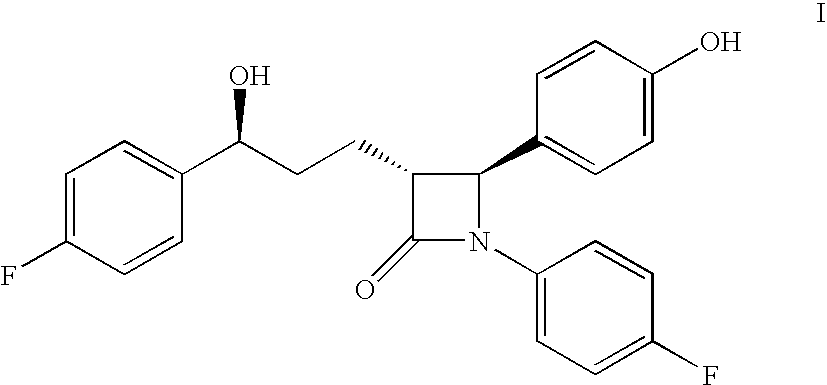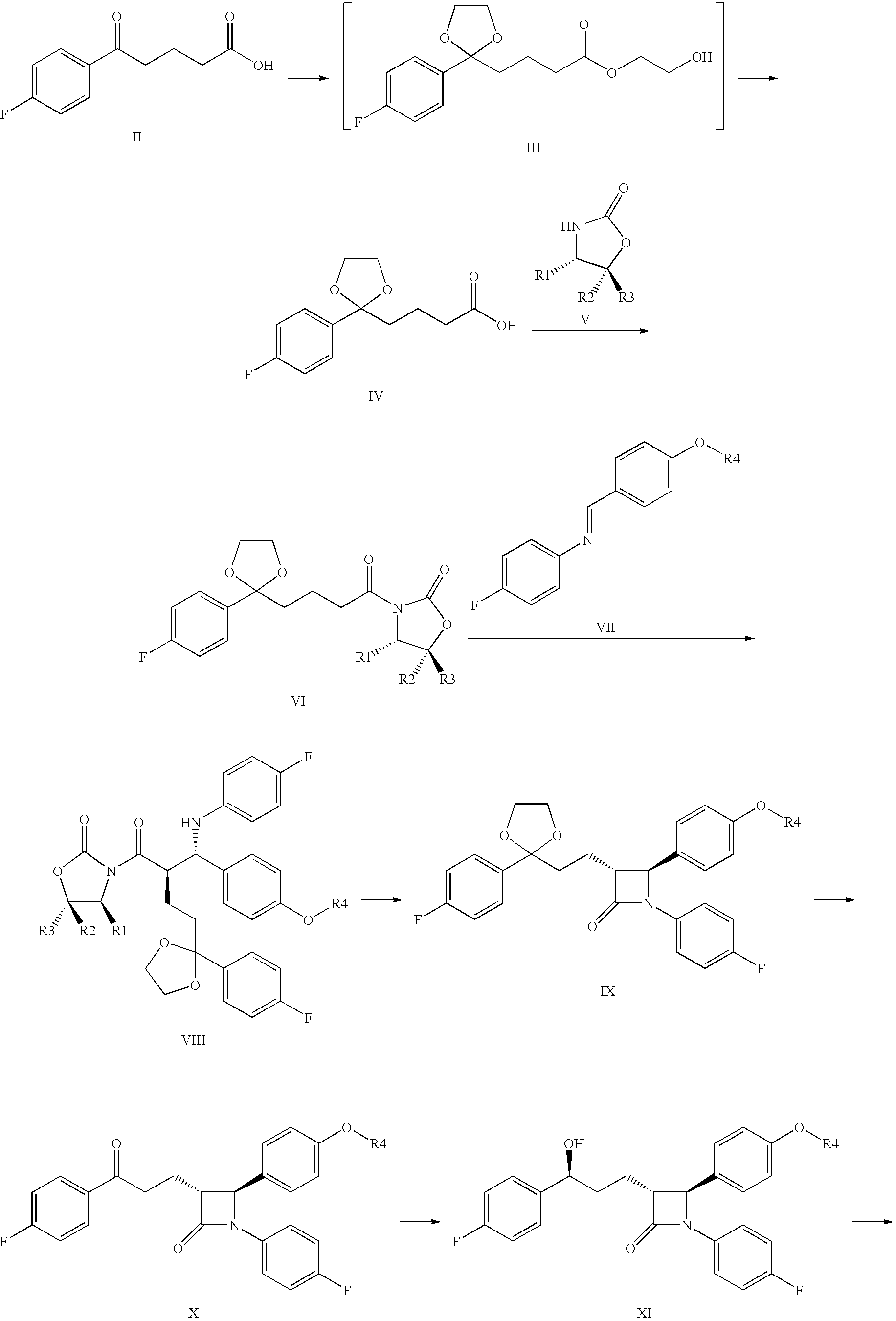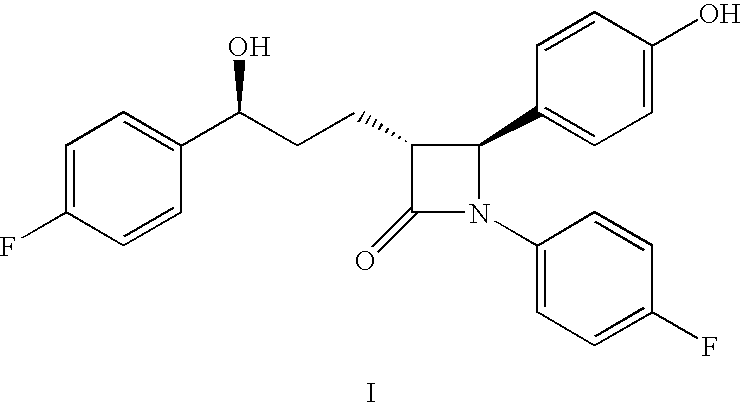Process for the production of ezetimibe and intermediates used in this process
a technology of ezetimibe and intermediates, which is applied in the direction of group 4/14 element organic compounds, organic chemistry, silicon organic compounds, etc., can solve the problems of increasing the cost of procedure, the yield of resolvation cannot be increased above 50%, and the cost of resolving cannot be increased. achieve the effect of convenient realization and economical
- Summary
- Abstract
- Description
- Claims
- Application Information
AI Technical Summary
Benefits of technology
Problems solved by technology
Method used
Image
Examples
example 1
Preparation of 4-[2-(4-fluoro-phenyl)-[1,3]dioxolane-2-yl]-butyric acid (IV)
[0054]21.0 g (0.1 mol) 4-(4-fluor-benzoil)-butyric acid (II) was weighed into a 500 ml round-bottom flask and suspended in 210 ml dichloro methane. During continuous stirring 28 ml (31.2 g, 0.5 mol) ethylene-glycol, 32 ml (31.04 g, 0.3 mol) trimethyl-ortho-formiate, and 0.5 ml conc. sulphuric acid is added dropwise into the suspension. The reaction mixture was stirred at 20-25° C. for 3-6 h. The reaction was analytically controlled by thin-layer chromatography. When the ketone came to an end, as its spot disappeared by thin-layer chromatography, the reaction was stopped with adding 5 g solid NaHCO3. The suspension was stirred for 05 min., then the solvent is removed by evaporation, and the residue is solved in 150 ml methanol. This solution was cooled in an icy water-bath, and during the cooling 100 ml 10% NaOH solution was added. The flask was closed and the turbid mixture was stirred at 20-25° C. for about...
example 2
Preparation of (S)-3-{4-[2-(4-Fluorophenyl)-[1,3]dioxolane-2-yl]-butyril}-4-phenyl-oxazolidine-2-one (VIa)
[0058]42 g (165 mmol) compound Formula IV, product of Example 1 was solved in 340 ml water-free terahydrofurane, and the vessel was rinsed by dry N2 gas. The solution was cooled to −20° C., and 55 ml (390 mmol) triethyl-amine was added. A mixture of 40 ml tetrahydrofurane and 20.2 ml pivaloyl chloride (19.8 g, 164 mmol) is added trough a drip-funnel for some 30 min at a temperature between −10° C. and −20° C. The precipitate-containing mixture was stirred for 2 h at a temperature between −10 and −20° C., and then 24.45 g (150 mmol) solid S (+)-4-phenyl-2-oxazolidinone (Va) and 7.5 g (177 mmol) water-free litium-chloride was sprinkled consecutively into it. Then the suspension was stirred for 4 h while it warmed up to 20-25° C.
[0059]The reaction was analytically controlled by thin-layer chromatography. When the spot of S (+)-4-phenyl-2-oxazolidinone decreased to 3%, the reaction ...
example 3
Preparation of (S)-3-{(R)-2-[(S)-[4-(tert-butyl-dimethyl-silanyl-oxy)-phenyl]-(4-fluoro-phenyl-amine)-methyl]-4-[2-(4-fluoro-phenyl)-[1,3]dioxolane-2-yl]-butyric}-4-phenyl-oxazolidine-2-one (VIIIa)
Preparation of Titanium-Trichloride-Isopropoxyde Reagent:
[0064]0.95 ml (0.9 g, 3.2 mmol) Ti(IV)-isopropoxyde was added into a solution of 0.99 ml (1.71 g, 9 mmol) TiCl4 made in 34 ml dichloromethane at 0° C. temperature and N2-atmosphere. The mixture was stirred for 15 min. at 0° C. This solution was used in the following coupling step.
Coupling (Method A)
[0065]4.0 g (10 mmol) compound of Formula VIa and 6.6 g (20 mmol) imine compound of Formula VIIIa are weighed into a 250 ml vessel supplied with a magnetic stirrer, a thermometer, a drip-funnel and a N2-inlet, and solved in 50 ml dichloromethane. The mixture is cooled to −40° C. and 3.6 ml (20.7 mmol) DIPEA was added. The titanium-trichloride-isopropoxyde reagent solution is gradually added trough the drip-funnel for about 30 min. The mixt...
PUM
| Property | Measurement | Unit |
|---|---|---|
| temperature | aaaaa | aaaaa |
| temperature | aaaaa | aaaaa |
| temperature | aaaaa | aaaaa |
Abstract
Description
Claims
Application Information
 Login to View More
Login to View More - R&D
- Intellectual Property
- Life Sciences
- Materials
- Tech Scout
- Unparalleled Data Quality
- Higher Quality Content
- 60% Fewer Hallucinations
Browse by: Latest US Patents, China's latest patents, Technical Efficacy Thesaurus, Application Domain, Technology Topic, Popular Technical Reports.
© 2025 PatSnap. All rights reserved.Legal|Privacy policy|Modern Slavery Act Transparency Statement|Sitemap|About US| Contact US: help@patsnap.com



